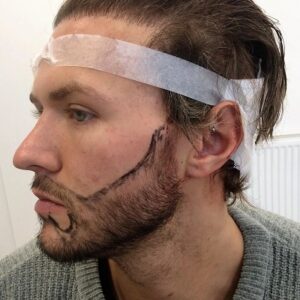
Growing a beard can be challenging for some men, even after allowing facial hair to grow naturally. Genetic factors can contribute to facial hair loss, as not everyone has the genetic makeup for a thick beard. However, advancements in cosmetic surgery and modern medicine have made it possible to grow the beard of one’s dreams. Some beard-growing techniques include using over-the-counter medications for a lush beard and better facial hair growth or seeking cosmetic surgery for longer-lasting benefits without constant medication use. Despite the challenges, there is hope for those struggling with organically facial hair growth. Let’s explore the impact of beard hair transplantation to unlock your confidence.
Understanding Beard Hair Transplantation:
A beard hair transplant involves transferring hair from one place of the body, typically the back of the scalp—to the area where the beard is to grow. A beard transplant may be appropriate for those lacking facial hair development due to scars or heredity.
How Beard Transplant Works?
There are two primary kinds of transplants for beards:
Extraction of follicular units (FUE):
Follicular Unit Extraction (FUE) is a popular method for beard transplantation, which involves taking individual hair follicles from the donor region, typically the back of the scalp, and incisions in the recipient’s beard area. This gentle procedure corresponds with the new beard hair’s density and direction. FUE produces fewer circular scars and less recuperation time compared to FUT. A FUE beard transplant typically takes one session, lasting six to ten hours. Two treatments may be necessary for noticeable hair loss or desired density.
Follicular unit transplantation (FUT):
FUT beard transplant, also known as strip surgery, involves removing a thin strip of tissue from the donor site, usually the back of the head, and separating it into grafts with one to four hair follicles. The grafts are inserted into recipient site incisions, similar to FUE transplants. FUT makes it easier to transplant bigger beards because it can transplant more hairs. However, FUT takes longer than FUE, ranging from 6 to 12 hours, depending on the region’s size and the number of grafts moved.
The Impact of Beard Hair Transplantation:
The impact of beard hair transplantation is greatly impressive. A long, well-groomed beard has more meaning than appearance; it speaks to one’s innermost self. A typical objective among those who want to have their beards transplanted is to have a beard that represents their desired masculinity. Achieving this ideal appearance may have a significant psychological influence by boosting self-assurance and confidence.
- It enhanced facial aesthetics through precision customization.
- Boosts self-esteem and confidence profoundly.
- Personal style evolution, influencing grooming and fashion choices.
- Positive social impact, altering perception, and making a mature impression.
- Psychological transformation, fostering a sense of self-assuredness.
- Tailored beard designs that complement individual features.
- Minimally invasive procedure with minimal downtime.
- Facilitates a style evolution that extends beyond the beard.
- Symbolizes overcoming personal insecurities.
- Influences interpersonal dynamics in various settings.
- Connects physical appearance to improved self-image.
- Represents a journey of self-discovery and confidence-building.
- A transformative procedure that goes beyond cosmetic enhancement.
Restoration And Aftercare of Beard Transplants:
- The healing period after a beard transplant is seven to fourteen days. You are free to go back to your regular activities after 14 days.
- You may begin shaving or trimming your new beard after three weeks. The new beard hairs may begin to shed and fall out after two to three weeks after a transplant. Hair loss is a natural part of the healing process after a transplant. New hair will grow in its place when this occurs.
- Refraining from handling your beard for the first five days after the treatment is suggested.
- After the first day, you may wash your face but leave the transplanted beard region alone. Gently pat yourself dry rather than rubbing.
- Do not go swimming in a pool for four weeks after the surgery.
- For the first week, sleep on your back with your head up to reduce the chance of edema.
Conclusion:
Transplanting beard hair is a voyage of self-discovery and confidence-building, not just a cosmetic operation. When people discover the potential of their facial hair, the effects extend beyond appearance and influence how they see themselves and others. Regarding aesthetic potential, beard hair transplantation is a monument to the strength of individual change and the deep relationship between confidence and one’s physical appearance.
For the best beard hair transplantation treatment and results, consult a qualified specialist at Dynamic Clinic Islamabad.











